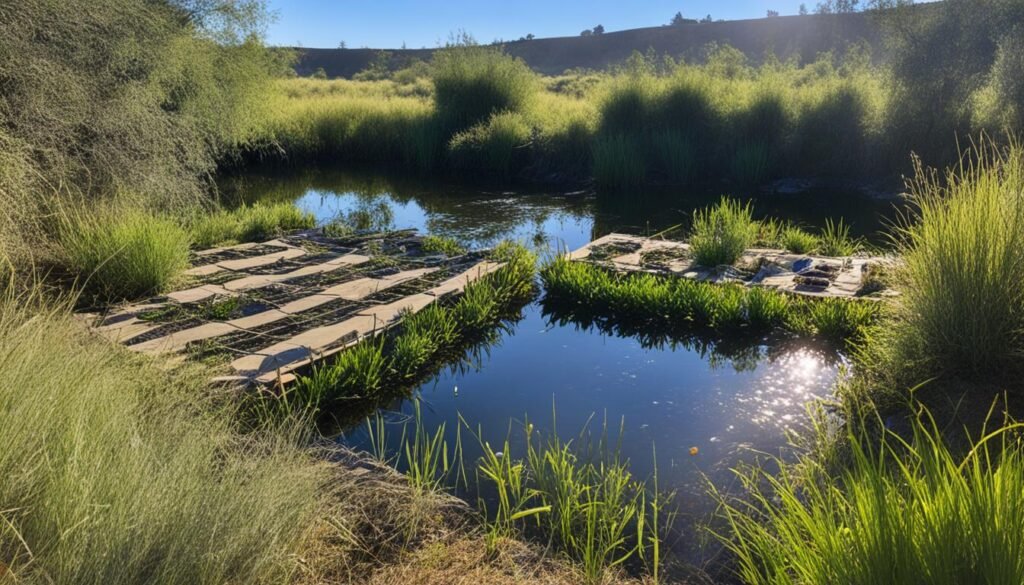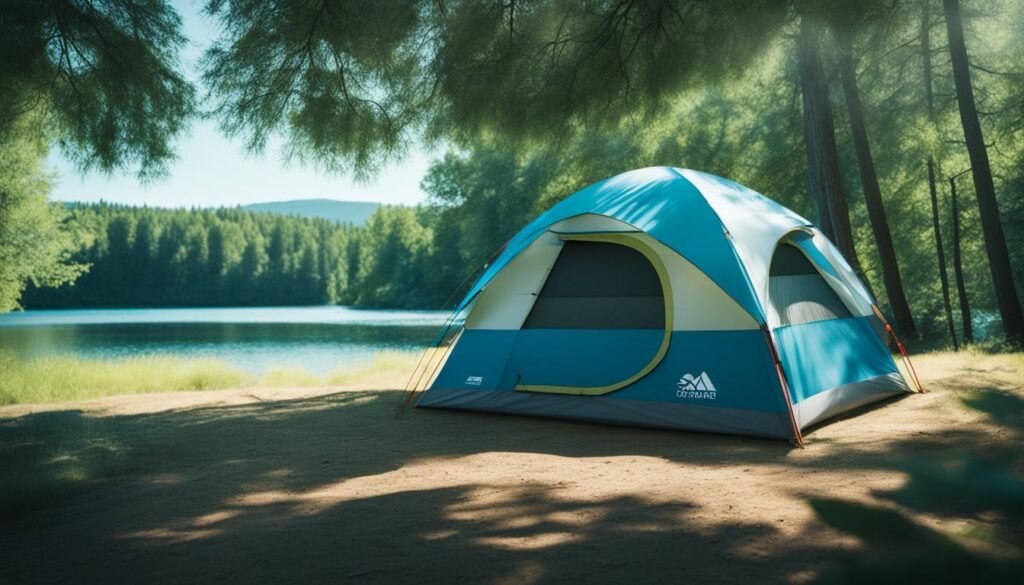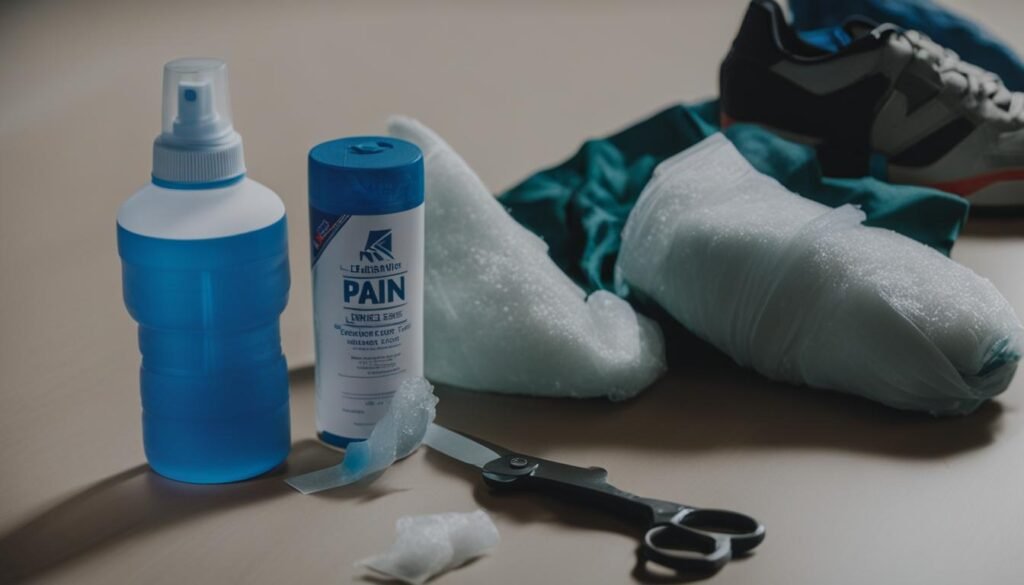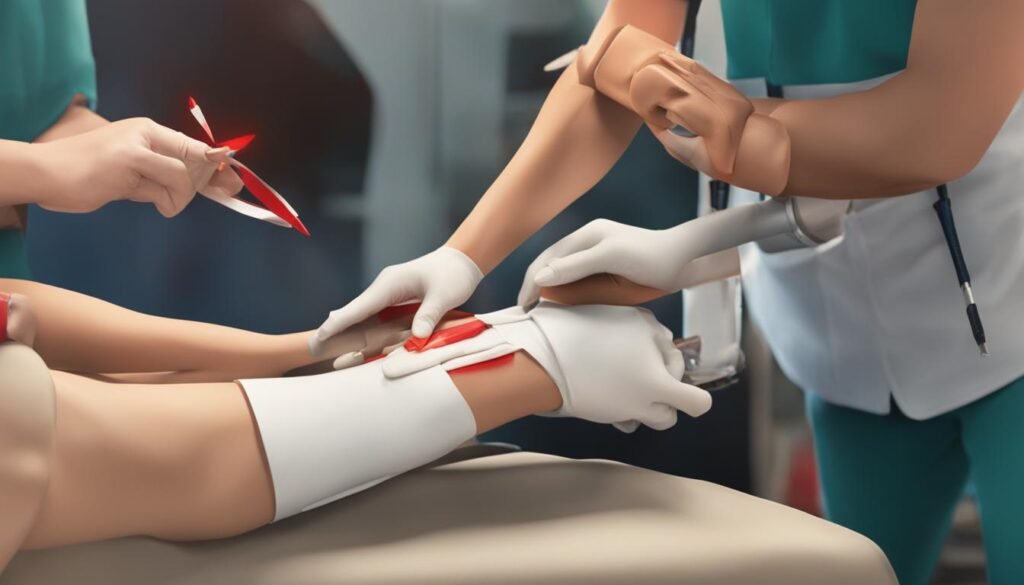As outdoor enthusiasts, one of the things we love most about camping is escaping into nature and disconnecting from the hustle and bustle of everyday life. However, it’s important to be mindful of the potential dangers that exist in the wilderness, including snakes.
Venomous snakes can pose a threat in many parts of the United States, with approximately 20 different species that can harm humans. To ensure a safe and enjoyable camping experience, it’s crucial to take precautions to keep snakes away from your tent area.
Here are some valuable tips and snake deterrents specifically designed for camping:
Key Takeaways:
- Choose a campsite location that is free from dense brush, rocks, fallen leaves, tree branches, and tall grass to eliminate potential snake hiding spots.
- Keep your campsite clean and properly dispose of food to avoid attracting snakes.
- Understand snake behavior and habitat to differentiate between harmless and dangerous snakes.
- Utilize natural snake repellents such as essential oils or ultrasonic pulse emitters to deter snakes.
- Dress appropriately for snake protection, including wearing closed-toe shoes and long pants.
By following these tips and utilizing snake deterrents, you can minimize the risk of encountering snakes while camping and ensure a safer and more enjoyable outdoor experience.
Understanding Snake Behavior and Habitat
Snakes are fascinating creatures with unique behaviors and specific habitat preferences. To effectively prevent snakes from entering your campsite and deter them while camping, it’s essential to understand their behavior and adapt your camping practices accordingly.
Snakes are ectothermic or cold-blooded creatures, meaning their body temperature depends on the environment they are in. They rely on external heat sources to regulate their body temperature. This behavior plays a crucial role in determining where they choose to reside within their habitat.
Snakes seek warmth to raise their body temperature and often bask in the sun or on warm surfaces, such as rocks or logs. These areas provide them with the necessary heat to carry out their physiological functions effectively.
On the other hand, when snakes need to lower their body temperature, they seek shade or cooler surfaces like burrows or dense vegetation. These shaded areas provide them with relief from excessive heat and help maintain their optimal body temperature.
Understanding the preferred seasons and climate of snakes is vital for preventing encounters while camping. Snakes are most active during warmer seasons, typically spring and summer, when temperatures are favorable for their activity and when they are more likely to encounter humans in outdoor settings.
In colder months, snakes become lethargic and dormant due to their ectothermic nature. They retreat to warmer locations or hibernate, making the likelihood of snake encounters significantly lower during this time.
When choosing a campsite, consider the following tips to prevent snakes from encroaching:
- Opt for an open campsite with relatively flat and even terrain, minimizing the presence of potential hiding spots for snakes, such as dense brush, rock piles, fallen leaves, branches, or tall grass.
- Stay away from areas near bodies of water, as these environments are attractive to some snake species for hunting and hydration.
- Ensure your campsite is well-maintained and free from debris that can entice or provide hiding spots for snakes.
- Set up your tent away from potential snake habitats, such as rock crevices, burrows, or areas with dense vegetation.
By understanding snake behavior and being selective about your campsite location, you can significantly reduce the chances of encountering snakes while camping.
The Snake Behavior and Habitat Table:
| Snake Behavior | Preferred Habitat |
|---|---|
| Snakes seek warmth to raise their body temperature. | Bask in the sun or warm surfaces like rocks or logs. |
| Snakes actively search for shade or cooler surfaces to lower their body temperature. | Hide in burrows, dense vegetation, or shaded areas. |
| Snakes are most active during warmer seasons. | Prefer areas with favorable temperatures for hunting and activity. |
| Snakes become lethargic and dormant during colder months. | Retreat to warmer locations or hibernate. |
Campsite Preparation and Maintenance
When it comes to camping safety from snakes, proper campsite preparation and maintenance play a crucial role. By taking necessary precautions and eliminating potential hiding places for snakes, you can significantly reduce the chances of encountering these reptiles. Here are some essential tips for snake-proofing your tent and ensuring a safe camping experience:
Select the Right Campsite
Choose a location that is free from dense brush, rock piles, fallen leaves, branches, and tall grass. These areas serve as ideal hiding spots for snakes. Opt for a campsite that is open, with a relatively flat and even terrain, as they are less attractive to snakes.
Landscape and Use a Camping Pad
If your chosen campsite is not already suitable, take the time to landscape it accordingly. Clear away any debris or potential snake hiding places. Additionally, consider using a camping pad beneath your tent to create a physical barrier between the ground and your sleeping area.
Keep Your Campsite Clean
Ensure that your campsite remains clean throughout your stay. Dispose of food waste properly and secure your food in sealed containers to avoid attracting snakes. Regularly clean up any spilled food or crumbs, as these can entice snakes to approach your campsite.
Inspect Your Tent and Gear
Regularly examine your tent for any openings or holes that snakes could use to enter. Repair any gaps or tears promptly to snake-proof your tent. Before using your sleeping bag or putting on your boots, thoroughly check them for any unwanted visitors.
Maintain a Tidy Campsite
Consistently maintain a clean and tidy campsite. Properly store your camping gear, keeping it organized and off the ground. By eliminating clutter and maintaining a clean camping area, you minimize the likelihood of attracting snakes.
By following these campsite preparation and maintenance tips, you can significantly reduce the risk of encountering snakes during your camping trip. Remember, being proactive about snake-proofing your tent and keeping your camping area clean and tidy is essential for ensuring your camping safety from snakes.
The Role of Campfires in Snake Deterrence
Snakes and other reptiles are affected by extreme heat and cold, including fire. Campfires can be an effective deterrent to keep snakes away from your camping area. Snakes dislike the heat and light that campfires produce, making them less likely to approach your campsite. Not only do campfires serve as a snake deterrent, but they also enhance the overall camping experience by providing warmth, illumination, and a cozy atmosphere.
When planning to have a campfire, it is essential to ensure you have the necessary tools to start and maintain it. Carry a Ferro rod or waterproof matches and pack tinder to easily ignite the fire. Proper campfire safety measures should always be followed to prevent accidents and contain the fire. It is crucial to fully extinguish the fire before leaving the campsite to eliminate any remaining warmth that could attract snakes.
While campfires can be an effective snake deterrent, it is important to note that they are not a foolproof method. Some snake species may not be deterred by the presence of a campfire, especially if they are in search of food or water. Therefore, it is still essential to implement other snake prevention strategies, such as choosing the right campsite and utilizing natural repellents.
| Benefits of Campfires as Snake Deterrents | Considerations when using Campfires |
|---|---|
|
|
To further enhance snake deterrence, consider using other natural repellents and following additional camping safety measures to minimize the risk of snake encounters.
Natural Snake Repellents and Deterrents
When it comes to keeping snakes away from your camping area, many commercial snake repellents on the market are not effective and may even be toxic to humans and mammals. To ensure your safety while enjoying the great outdoors, it’s best to explore natural alternatives that can effectively deter snakes without posing any harm.
One natural snake repellent option is to use essential oils mixed with water. Cinnamon and clove essential oils are known to repel snakes due to their strong scents. Simply mix a few drops of these oils with water in a spray bottle and apply the mixture around your campsite and tent perimeter. This natural deterrent can create a scent barrier that snakes will want to avoid. Make sure to reapply the spray every few days or after rain for maximum effectiveness.
The Benefits of Essential Oils as Snake Repellents
Essential oils offer several advantages as snake repellents for tent camping:
- Natural and non-toxic: Essential oils are derived from plants and are safe for humans and the environment.
- Pleasant smell: Cinnamon and clove oils have a pleasant aroma, which can enhance your camping experience.
- Ease of use: Mixing essential oils with water in a spray bottle is a simple and convenient way to apply the repellent.
Another option for natural snake deterrence is the use of portable solar-powered ultrasonic pulse emitters. These devices emit high-frequency sound waves that snakes are sensitive to, causing them to stay away from the area. Simply place these emitters strategically around your campsite to create a snake-free zone.
The Advantages of Ultrasonic Pulse Emitters
Here are some reasons why ultrasonic pulse emitters are gaining popularity as snake deterrents:
- Safe and humane: Ultrasonic pulses do not harm snakes or other wildlife; they simply create an uncomfortable environment for snakes, encouraging them to leave.
- Portable and easy to use: These emitters are typically lightweight and compact, making them convenient to carry and set up at your campsite.
- Solar-powered: With no need for batteries or electricity, ultrasonic pulse emitters utilize solar energy to operate, making them eco-friendly and cost-effective.
By utilizing natural snake repellents and deterrents, you can enhance your camping experience while minimizing the risk of encountering snakes. Whether you choose the aromatic protection of essential oils or the high-frequency pulses of ultrasonic emitters, these natural solutions provide effective alternatives to commercial snake repellents.
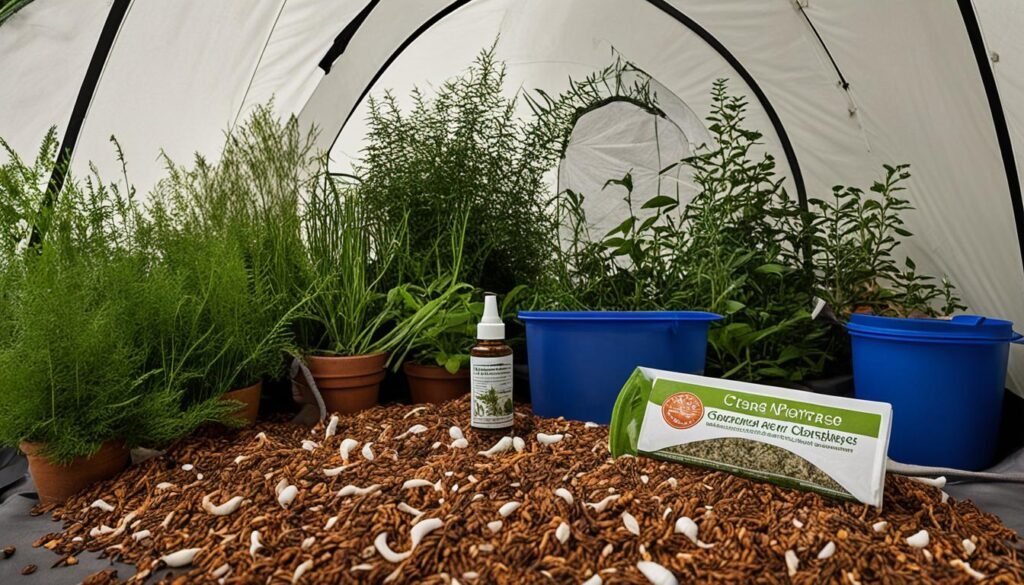
| Snake Repellent | Advantages |
|---|---|
| Essential oils (cinnamon and clove) |
|
| Ultrasonic pulse emitters |
|
Utilizing Weapons as a Last Resort
While it is best to avoid provoking snakes if you encounter them, there may be situations where repelling a snake becomes necessary. In such cases, there are a few options you can consider, including using weapons as a last resort.
One effective tool for repelling snakes is a flat shovel. This can be used to gently guide the snake away from your campsite or hiking path without causing harm to the snake or yourself.
Another option is to use snake-shot cartridges, which are specifically designed for snake repelling. These cartridges contain birdshot contained within a plastic projectile, reducing the risk of ricochet. It is essential to test the ammunition on a firing range before loading your handgun to ensure accuracy and reliability.
Keep in mind that using weapons should only be considered as a last resort and avoidance should always be the priority. It is important to remember that snakes play a vital role in ecosystems and should be respected.
To provide a visual representation of the effectiveness of weapons for snake repelling, the following table showcases the pros and cons of utilizing weapons:
| Weapon | Pros | Cons |
|---|---|---|
| Flat Shovel | – Non-lethal option – Allows for guiding snakes away |
– Requires close proximity to the snake – May cause panic or aggression in some species |
| Snake-Shot Cartridges | – Specifically designed for snake repelling – Reduces risk of ricochet |
– Requires firearm proficiency and safety precautions – May cause harm to the snake if not used properly |
The Role of Weapons in Snake Repelling
“Using weapons for snake repelling should only be considered as a last resort, with avoidance always being the priority.”
It is important to note that weapons should be used responsibly and in accordance with local laws and regulations. Always prioritize your safety and the safety of others when dealing with snakes.
Dressing Appropriately for Snake Protection
When camping in areas where snakes are present, it is crucial to dress in a way that provides adequate protection against snake bites. By choosing the right clothing and footwear, you can significantly minimize the risk of encountering snakes and ensure your safety during outdoor adventures.
Protective Footwear
One of the first steps in dressing for snake protection is to avoid open-toed shoes, sandals, or flip-flops. Instead, opt for dedicated hiking boots that provide increased snake bite protection. Look for boots that are made of sturdy materials, such as thick leather or snake-proof fabric, and have a high ankle coverage to prevent snake fangs from reaching your skin. Reliable hiking boots with sturdy construction can create a barrier between your feet and potential snake strikes.
Long Pants and Protective Clothing
Wearing long pants while camping in snake-prone areas is essential. Long pants provide a physical barrier, reducing the chance of a snake’s fangs penetrating your skin. Choose pants made from durable materials, such as heavy denim or thick canvas, that can withstand potential encounters with vegetation or rough terrain. Additionally, consider wearing clothing that covers the skin, including long-sleeved shirts or jackets. These layers of clothing act as a buffer between your body and any potential snake bites.
Gaiters and Snake-Proof Boots
For added protection against snake bites, consider investing in gaiters or snake-proof boots. Gaiters are protective coverings that wrap around the lower leg, shielding your ankles and calves from snake strikes. They are typically made from durable materials, such as nylon or waterproof fabric, and feature secure closures to prevent snakes from accessing your skin. Snake-proof boots are specifically designed to resist snake bites, with reinforced materials and construction that provide enhanced protection for your feet and lower legs. These specialized boots are a worthwhile investment for those camping in areas with a high snake population.
By dressing appropriately for snake protection, you can reduce the risk of snake encounters and potential bites during your camping trips. Remember to prioritize your safety and take necessary precautions to enjoy the great outdoors without unnecessary risks.
| Dressing for Snake Protection | Benefits |
|---|---|
| Protective Footwear | – Provides increased snake bite protection. – Creates a barrier between your feet and potential strikes. – Sturdy construction offers durability and stability. |
| Long Pants and Protective Clothing | – Reduces the chance of snake fangs penetrating the skin. – Acts as a physical barrier against potential snake bites. – Offers protection from vegetation and rough terrain. |
| Gaiters and Snake-Proof Boots | – Provides additional protection for ankles and lower legs. – Shields against snake strikes and potential bites. – Specialized materials and construction resist snake bites. |
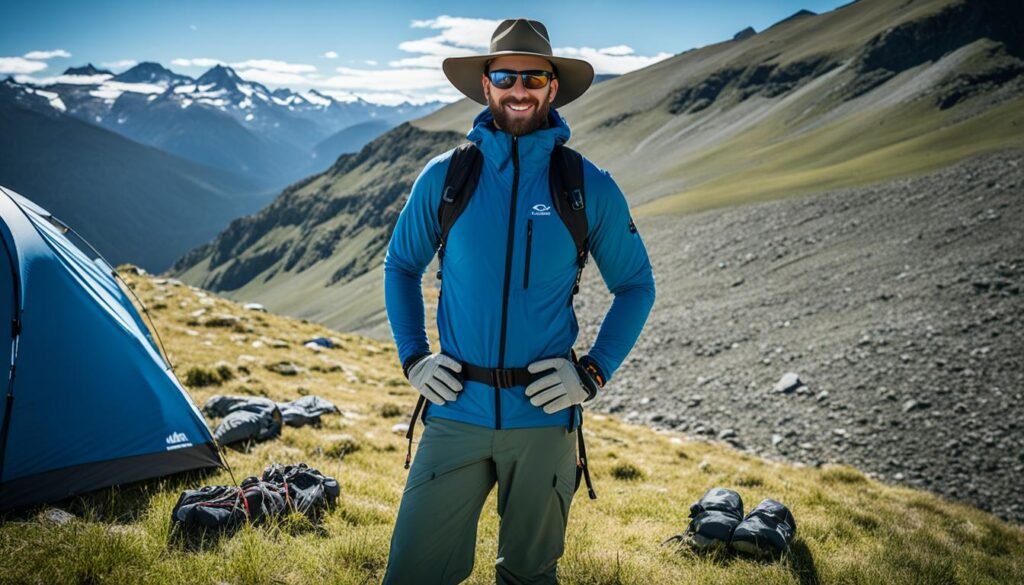
Snakebite First Aid and What Not to Do
If someone is bitten by a snake, it is crucial to act quickly and seek medical help. The first step is to keep the person calm and still, as movement can increase the venom’s spread. It’s essential to place the bite location below the heart level, such as by keeping the affected limb immobilized and at rest, to slow down the venom’s circulation.
When dealing with snakebites, it is essential to know what not to do. Contrary to popular belief, do not try to suck out the venom using your mouth, as this could introduce harmful bacteria and viruses into the wound. Additionally, cutting the wound or applying a tourniquet are ineffective and potentially harmful measures that should not be attempted.
Carrying a well-stocked first-aid kit is crucial for any camping trip, as it should include items specifically designed for snakebite treatment. These may include sterile dressings, bandages, antiseptic wipes, and a snakebite suction device. It is essential to familiarize oneself with the proper use of these items and the appropriate first aid measures for snakebites.
What Not to Do if Bitten by a Snake:
- Do not suck out the venom using your mouth.
- Do not cut the wound or attempt to drain the venom.
- Do not apply a tourniquet or constricting band above the bite.
- Do not use ice or cold packs on the bite.
Remember, the priority is to seek immediate medical help and follow the guidance of healthcare professionals when dealing with snakebites. Proper knowledge and preparation can make a lifesaving difference in such situations.
| Snakebite First Aid Dos | Snakebite First Aid Don’ts |
|---|---|
| Seek immediate medical help. | Do not suck out the venom using your mouth. |
| Keep the person calm and still. | Do not cut the wound or try to drain the venom. |
| Keep the bite location below heart level. | Do not apply a tourniquet or constricting band. |
| Carry a well-stocked first-aid kit. | Do not use ice or cold packs on the bite. |
Snake Repellents Historically Used by Cowboys
Cowboys in the Wild West were resourceful in finding ways to keep snakes away from their campsites. They relied on various techniques and tools that proved practical and effective. Let’s explore some of the historical snake repellents and deterrents used by these rugged individuals.
- Campfires: Cowboys knew that snakes avoid the heat and light emitted by campfires. They would build a roaring fire to create an unwelcoming environment for these slithering creatures.
- Thick Leather Boots: Cowboys always wore thick leather boots for snake bite protection. With their sturdy footwear, they could confidently navigate through snake-infested terrains.
- Campsite Clearance: Cowboys would meticulously clear their campsites of rocks, logs, and tall grass where snakes might hide. By eliminating potential hiding spots, they reduced the chances of encountering these reptiles.
- Herbs and Strong-Smelling Plants: Some cowboys planted herbs and plants with strong odors, such as garlic and onions, around their campsites. Snakes have a sensitive sense of smell and are often repelled by pungent aromas.
- Utilizing Horses: Cowboys knew that snakes tend to avoid areas frequented by horses. They would keep their trusty steeds close by to deter snakes from approaching their campsites.
- Snake Sticks: Cowboys carried snake sticks, which were long poles with a gentle fork or hook at the end. If they encountered a snake in their path, they could use the stick to guide the snake away without harming it.
These historical snake repellent methods employed by cowboys showcased their resourcefulness and practicality in dealing with the presence of snakes. Whether it was through campfires, suitable footwear, or plant choices, cowboys found ways to coexist with their reptilian neighbors.
Looking back at these techniques can provide valuable insights for campers today who want to keep snakes at bay during their outdoor adventures.
Stay tuned for the final section of our article, where I’ll share personal safety tips to ensure a safe and enjoyable camping experience.
Are the Methods for Keeping Insects Out of Tents Also Effective for Keeping Snakes Away?
Yes, effective insect protection methods like using sealed zippers and mesh screens can also help keep snakes out of tents. Keeping the tent area clear of debris and sealing any gaps in the tent floor can further deter snakes from entering the space.
Personal Safety Tips for Camping
In addition to snake-specific precautions, there are general safety tips that can help ensure a safe camping experience. It’s important to prioritize your personal safety while enjoying the great outdoors.
1. Wear protective clothing
Reduce the risk of snake bites by wearing appropriate clothing. Opt for long pants and closed-toe shoes to minimize exposure to snakes. This simple measure can provide an added layer of protection.
2. Carry a snake stick
When hiking in snake-prone areas, consider carrying a snake stick. This tool can offer added confidence and safety by allowing you to safely navigate your surroundings and keep snakes at a safe distance.
3. Stick to established trails
To minimize the chances of encountering snakes, it’s best to stick to established trails. These paths are typically well-maintained, reducing the likelihood of stumbling upon snakes in their natural habitats.
4. Educate yourself about local snake species
Understanding the local snake species and their habits is crucial for identifying harmless snakes from venomous ones. Take the time to educate yourself about the types of snakes that are prevalent in the area you plan to camp in.
5. Enhance your camping safety
By following personal safety tips, you can enhance your overall camping safety and minimize the risk of snake encounters. Remain vigilant, stay informed, and be prepared for any potential wildlife encounters.
| Tips | Description |
|---|---|
| Wear protective clothing | Opt for long pants and closed-toe shoes |
| Carry a snake stick | Use a snake stick for added safety while hiking |
| Stick to established trails | Follow established paths to minimize snake encounters |
| Educate yourself about local snake species | Learn about the snakes in the area and their habits |
By incorporating these personal safety tips into your camping routine, you can enjoy a safe and memorable outdoor experience, free from snake-related concerns.
Conclusion
Camping in snake-prone areas requires awareness and precautionary measures to keep snakes away. Understanding snake behavior and habitat, choosing the right campsite, proper food and waste management, and using natural deterrents can help minimize the risk of encountering snakes while camping.
Dressing appropriately, using first aid for snake bites, and following personal safety tips are crucial for a safe camping experience. By being proactive and informed, you can enjoy the great outdoors and reduce the likelihood of snake encounters during camping trips.
Remember, prevention is key when it comes to snakes. By taking the necessary precautions and implementing the strategies discussed in this article, you can significantly reduce the chances of encountering these reptiles during your camping adventures. Stay informed, stay safe, and make the most of your time in the wilderness!
FAQ
How can I keep snakes away from my tent while camping?
To keep snakes away from your tent while camping, choose a location that is free from dense brush, rock piles, fallen leaves, tree branches, and tall grass. Keep your campsite clean and dispose of food properly to avoid attracting snakes.
What are some natural ways to deter snakes while camping?
Some natural ways to deter snakes while camping include using essential oils like cinnamon and clove mixed with water as a spray around your campsite and tent perimeter. You can also consider using portable solar-powered ultrasonic pulse emitters that emit high-frequency sound waves that snakes are sensitive to.
How can I snake-proof my tent and campsite?
To snake-proof your tent and campsite, select a location without dense brush, rock piles, fallen leaves, branches, and tall grass. Keep your campsite clean and ensure that no food is left lying around that could attract snakes. Regularly examine your tent for any openings or holes that snakes could enter.
Do campfires help keep snakes away?
Yes, campfires can help keep snakes away as they dislike the heat and light. Snakes are attracted to warm surfaces to raise their body temperature, so a campfire can deter them from approaching your camping area. Always follow campfire safety measures and fully extinguish the fire before leaving the campsite.
What are some effective snake repellents for tent camping?
Some effective snake repellents for tent camping include using natural deterrents such as essential oils like cinnamon and clove mixed with water as a spray, and portable solar-powered ultrasonic pulse emitters that emit high-frequency sound waves that snakes are sensitive to.
When should I consider using weapons as a last resort for snake repellent?
Using weapons should only be considered as a last resort for snake repellent. It is best to avoid provoking snakes if you encounter them. However, if repelling a snake becomes necessary, a flat shovel or snake-shot cartridges containing birdshot can be effective tools. Always exercise caution and follow safety guidelines when using weapons.
How can I dress appropriately to protect myself from snake bites while camping?
To protect yourself from snake bites while camping, avoid open-toed shoes and opt for dedicated hiking boots that provide increased snake bite protection. Wear long pants and clothing that covers the skin to reduce the risk of snake bites. Consider investing in gaiters or snake-proof boots for added protection.
What should I do if someone is bitten by a snake while camping?
If someone is bitten by a snake while camping, it is important to act quickly and seek medical help. Keep the person calm and still, with the bite location below the heart to slow the venom’s spread. Do not try to suck out the venom, cut the wound, or apply a tourniquet, as these methods are ineffective and potentially harmful.
Did cowboys use any snake repellent techniques in the past?
Yes, cowboys in the Wild West utilized various techniques to keep snakes away. They relied on campfires, wore thick leather boots for snake bite protection, cleared their campsites of rocks, logs, and tall grass, and planted herbs and plants with strong smells like garlic and onions to deter snakes. They also used horses to keep snakes away and carried snake sticks to gently guide snakes away from their path.
What are some personal safety tips for avoiding snake encounters while camping?
Personal safety tips for avoiding snake encounters while camping include wearing protective clothing such as long pants and closed-toe shoes, carrying a snake stick for added confidence and safety while hiking, and sticking to established trails to minimize the chances of encountering snakes. Additionally, educating yourself about local snake species and their habits can help you identify harmless snakes from venomous ones.

